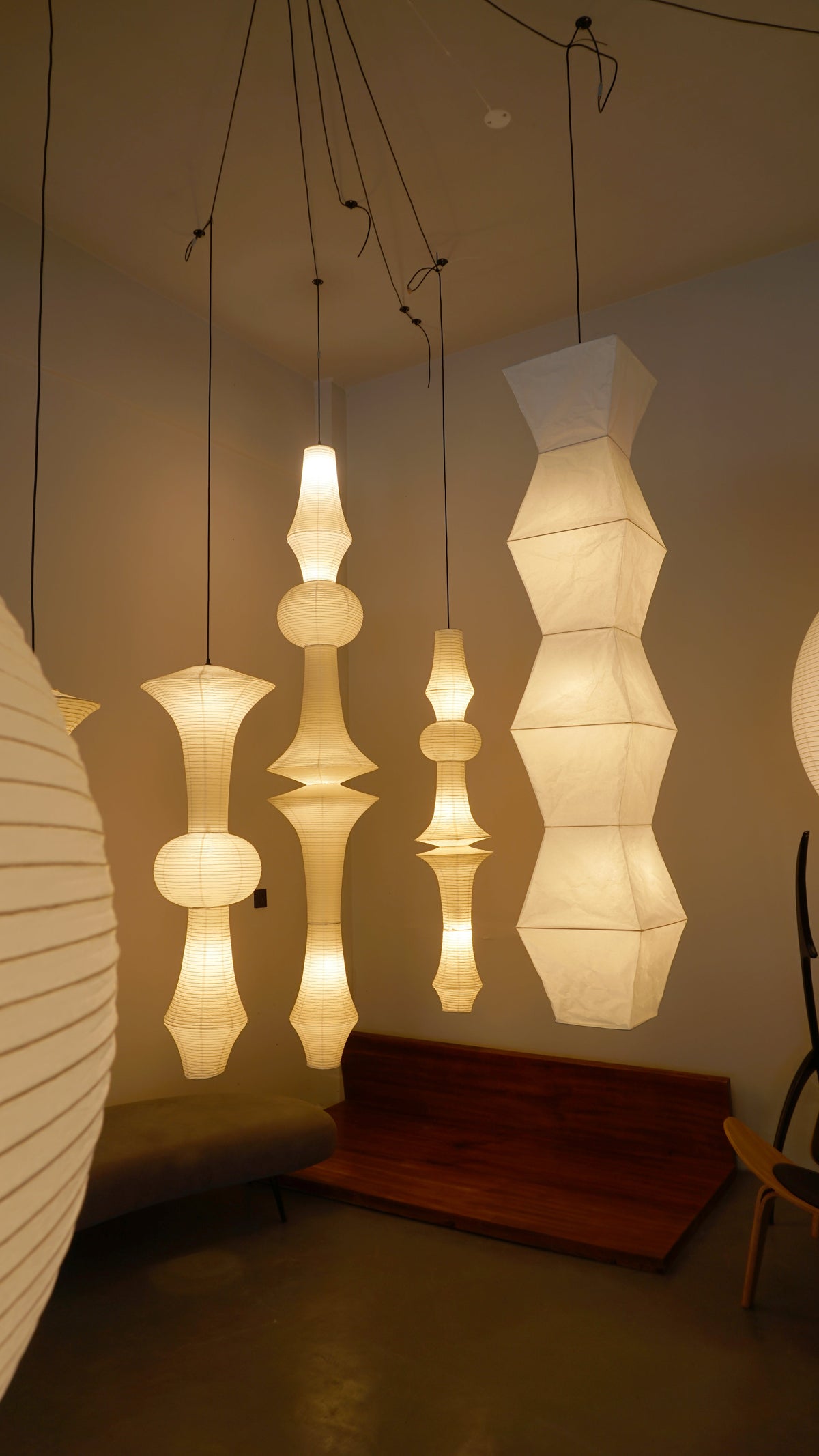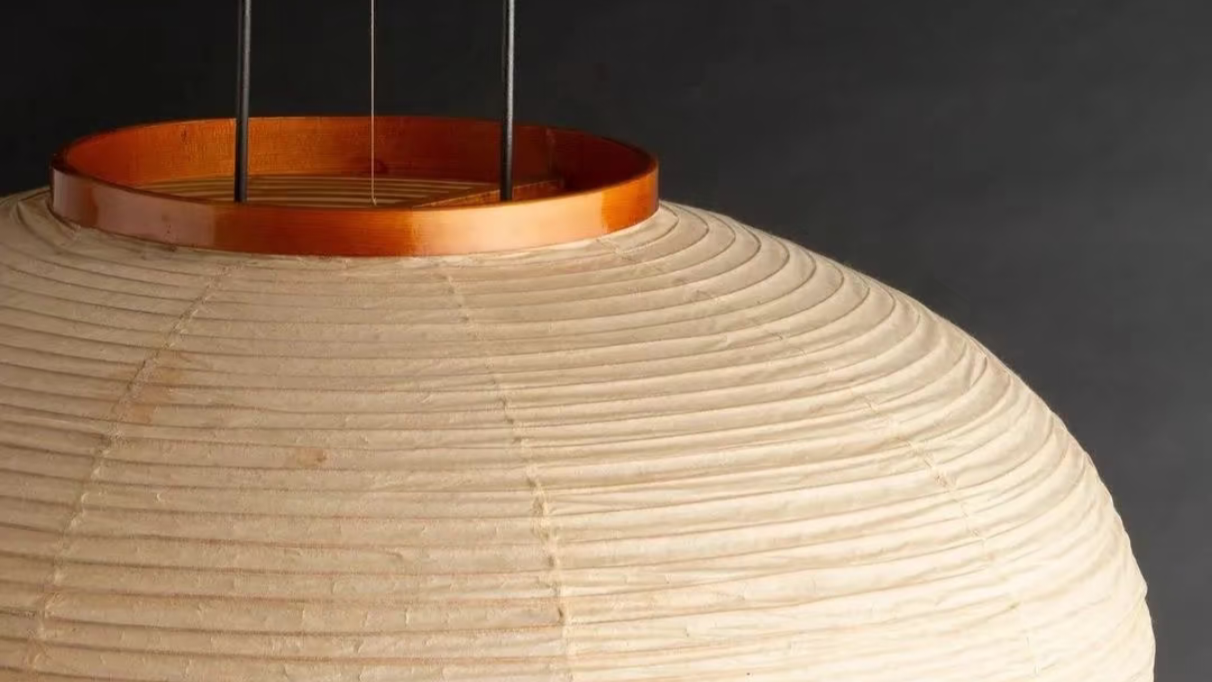
Why make an Akari lamp?
Akari lamps—Isamu Noguchi’s electrified paper sculptures—turn simple materials (washi paper + ribs) into a soft, warm light that flatters rooms and people. Originals are made by expert artisans in Gifu, Japan, using molds, bamboo ribs, and hand-applied washi; this guide shows both that traditional approach and easier DIY alternatives you can do at home.
Materials & tools (basic and optional upgrade list)
Basic (easy, inexpensive):
-
Sturdy cardboard or thin plywood discs (for inexpensive molds)
-
Thin flexible wooden dowels, rattan, or umbrella ribs (for ribs)
-
Rice paper / white craft paper / washi-style paper (choose heavier washi when possible)
-
PVA glue or craft adhesive, brush
-
Light socket with cord (E26/E27) rated for household use, plug, and switch
-
Small base (wood block) or tripod stand
-
Scissors, utility knife, ruler, pencil, clamps
Upgrade (closer to Noguchi method):
-
Proper washi paper (Mino-washi) and bamboo strips
-
Wooden shaping mold (turned wood form) for precise shapes
-
Special glue suited for paper laminating
-
Sewing needle and thread for finishing seams
Safety note: Work with low-heat LED bulbs to avoid heat buildup. Ensure the electrical parts are UL-rated for your country.
The simple DIY approach — step by step (good for a first lamp)
This version uses affordable materials and gives lovely results without specialized tools.
-
Plan your shape. Sketch a simple round, oval, or stacked form. Common Akari shapes are spheres, ovals, or layered shells (think Akari 1A or 24N proportions).

-
Make a mold. Cut two identical cardboard discs and stack rings to make a temporary mold that gives the lamp a smooth shape. For a sphere, use concentric rings; for an oval, a pair of cut forms glued to a spine works.

-
Create the rib skeleton. Bend flexible dowels or umbrella ribs and attach them across the mold, evenly spaced, like the ribs on a lantern. Secure at top and bottom with glue or small screws. This creates the frame that supports the paper. (Noguchi’s craftsmen stretch thin bamboo ribs over a wooden form in the original process.)

-
Attach the paper. Cut sheets of washi-style paper into panels long enough to wrap between ribs. Apply PVA glue sparingly to the ribs and press the paper onto the frame. Work in sections to avoid wrinkles. Overlap seams slightly and use a brush to smooth glue.


-
Trim & finish. Once dry, trim excess paper. If using a collapsible design, a light inner ring can hold shape but allow folding (the original Akari can collapse flat because of mold removal).

-
Install electrical parts. Fit the light socket centrally. Use low-heat LED bulbs (warm color temperature ~2700K–3000K) for the classic warm glow. Secure wiring per safety standards, and mount the lamp on a stable base or hanging canopy.

-
Test & enjoy. Power on, check for even diffusion and any hot spots. Replace with lower wattage bulbs if light appears too intense.
For a visual reference of artisans using wooden molds and bamboo ribs, the Noguchi Museum and manufacturing videos are very helpful. They show how the paper is applied, dried, and the mold removed to yield the final form. The Noguchi MuseumYouTube
A more authentic route — key differences if you want to match Noguchi’s quality
If you want an Akari that behaves like the museum pieces (and you have more time and skill):
-
Use a turned wooden mold to get precise curves. Artisans build a wooden form, stretch bamboo ribs tightly, then glue hand-made Mino-washi paper strips over the ribs. After drying, the wooden mold is removed so the lantern can be slightly collapsible.
-
Work with genuine washi for the most natural diffusion. Washi has texture and fiber that create the signature soft shadows.
-
Consider a local studio or maker space that can help with turning a wooden mold or bending bamboo ribs.
Troubleshooting & tips
-
Wrinkles: Apply paper in small panels and smooth with a soft cloth; don’t stretch paper too tight.
-
Sagging: Add more ribs or a gentle internal ring to support the shape.
-
Hot spots/heat: Always use LED bulbs and ensure at least 2–3 cm clearance between the bulb and paper.
-
Durability: Reinforce seams at top and bottom with thin cloth tape under the paper for extra strength.
If you prefer step-by-step photos and community hacks, several DIY posts and instructables show creative, low-cost methods (using recycled lamp parts or IKEA lamp parts as a starting point). These are great for inexpensive experiments.
Final thoughts — light as gentle design
Making an Akari-style lamp is a satisfying craft: modest materials (paper + ribs) yield a rich, living light. Whether you build a simple paper globe for your bedside or attempt a wooden mold with bamboo ribs and real washi, the reward is the same — a warm, textured light that turns ordinary evenings into gentle, memorable moments.




0 comentarios